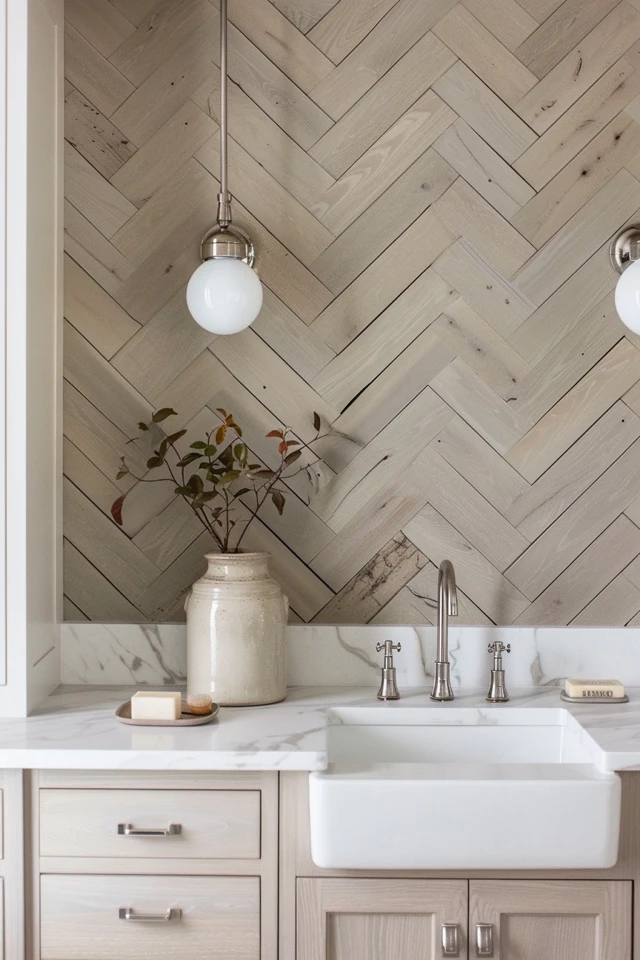Adding a herringbone pattern to your bathroom wall can instantly elevate the space with a touch of timeless elegance and modern flair. Whether you’re planning a bathroom renovation or just looking to update your interior design, herringbone bathroom walls are a popular choice. The intricate tile layout creates a stunning visual effect that can transform any bathroom into a stylish and chic oasis.
Key Takeaways:
- Herringbone bathroom walls add timeless elegance and modern flair to any space.
- The herringbone pattern works well with various design styles, from Scandinavian to modern and contemporary.
- Creating a herringbone tile layout requires careful planning and attention to detail.
- Start by finding the center point of the wall and tile outwards to create a symmetrical look.
- Experiment with different tile options, finishes, and colors to create a unique and personalized herringbone bathroom wall.
Herringbone Pattern for a Bold and Personalized Bathroom
The herringbone pattern is not only visually stunning but also adds character to any bathroom. It can be used in various design styles, from Scandinavian to modern and contemporary. The versatility of the herringbone pattern allows it to work well with other types of tiles, such as subway, skinny stacked, and Zellige.
Whether you’re looking for a bold and eye-catching bathroom or a chic and contemporary space, the herringbone pattern can be adapted to suit your style. From art deco-inspired bathrooms with chevron-clad tiles to coastal bathrooms with blue herringbone and white marble tiles, there are countless possibilities to create a personalized and unique bathroom design.

Endless Possibilities with the Herringbone Pattern
When it comes to herringbone bathroom designs, the options are truly endless. You can choose from a range of tile materials, colors, and finishes to create the perfect look for your bathroom renovation.
The herringbone pattern adds a sense of sophistication and style to any bathroom. It’s a classic design element that never goes out of fashion.” – Emily Johnson, Interior Designer
For a modern bathroom, you can opt for sleek subway tiles in a herringbone pattern. The clean lines and crisp edges of the tiles will give your bathroom a contemporary feel. If you prefer a more rustic look, consider using wood-look tiles in a herringbone pattern. This will add warmth and texture to your space.
Don’t be afraid to mix and match different tile sizes and shapes to create a unique herringbone design. You can combine larger rectangular tiles with smaller square tiles to add visual interest. Experiment with different colors and finishes to create a personalized and one-of-a-kind bathroom design.

Expert Advice on Herringbone Tile Installation
Installing herringbone tiles requires precision and careful planning. It is recommended to hire a professional tiler for the job, especially if you’re new to tile installation. However, if you’re confident in your DIY skills, there are resources available online that provide step-by-step tutorials and videos on how to create a herringbone tile layout.
- Start by finding the center point of the wall where you want to install the herringbone tiles. This will ensure a symmetrical layout.
- Use a speed square to create precise angles of 90 degrees for the tiles.
- Begin tiling from the center and work your way outwards, laying the tiles in the herringbone pattern.
- Once the tiles are installed, use grout to fill the gaps between the tiles.
Remember to take your time and pay attention to detail when installing herringbone tiles. The end result will be a stunning and personalized bathroom design.
Creating a Herringbone Tile Layout for Your Bathroom
Creating a herringbone tile layout for your bathroom requires careful planning and attention to detail. The classic herringbone pattern is created by laying rectangular tiles at a 90-degree angle to each other. This pattern dates back to Roman times and is commonly seen in textiles as well.
Most herringbone tile patterns use subway tiles, but you can create the pattern with any sized rectangular tiles. To create a symmetrical look, start by finding the center point of the wall and tile outwards from there. Use a speed square to ensure precise angles.
There are plenty of online tutorials and videos available to guide you through the process, or you can hire an experienced tiler for the job. Once you’ve mastered the herringbone tile layout, you can explore various tile options, from wood-look floor tiles to simple white tiles with black grout for a stylish contrast. Don’t be afraid to mix different tile finishes, such as glossy and matt, or experiment with different colors for a unique and personalized herringbone bathroom wall.


